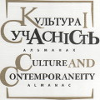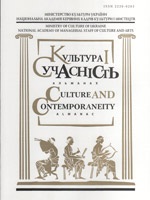THE TABLEFUL CULTURE OF THE ANCIENT GREEKS
DOI:
https://doi.org/10.32461/2226-0285.2.2015.146875Keywords:
Culture, culinary culture, tableful, Ancient Greece, aesthetics, cooking banquetAbstract
The article deals with the specifics of culinary culture in the ancient Greece, the particularly aesthetic design of the tableful are analyzed.
The traditional culture of the Greek tableful has become the foundation on which later the Mediterranean culinary tradition is formed, which was in the wide use of the different vegetables, fruits, cereals, meat, olive oil, wine etc. The Greeks and Romans turned into a ritual the table serving traditions, lush tablefuls. The Greeks considered the cookery skill as music and poetry.
The distinctive traditions of the cooking and eating with family and with the participation of the guests are the integral part of the culture of every nation. The phenomenon of the meal of the the ancient Greeks, forming for more than three millennia were seen by them with aesthetic pleasure. The art of the skilful cooks was equated by the public opinion with the elegant ancient Greek literature. Later, the Romans, except for the state-polis culture, philosophy and poetry, had borrowed also the achievements of the Greek cooking.
Greek mythology associates the appearance of the cooking with the figure of the cook Kulina – the maid of the Asclepius’ daughter and goddess of the health Gig. Kulina was considered as the patron and founder of the Cooks’ professions. Their professional training was lasting at least two years under the supervision of the experienced chef with mandatory of the final examination. The establishment of the ethnocultural colored cooking of the ancient Greeks chronologically was fixed in the period of the Pericles’ reigning. By the time they possessed the art of the baking of the pies with meat and vegetable filling.
In the heyday of the ancient Greek civilization the modern cooking and nutrition, along with the classic ritualization of the festive tableful are founded. The poultry, fish and other meat were brought to the Greek table as the first dishes, the fruit and sweets were the second and the fine wines were on the table as the third. The ritualized consumption of the wine in the ancient Greece was associated with the honouring of Dionysus – the god of the vegetation and fertility, the moisture and patron of the viticulture and winemaking. The cult of Dionysus was recorded in the clearly defined national holidays cycling. During the small, or rural, Dionysius annually in December were organized in the villages on the first testing of the wine, the noisy procession took place with the cheerful songs and dances, rude jokes and improvised performances by the itinerant actors. The holiday of the wine vats, Lenei, the Greek people celebrated in the Athens with the games, funs, noisy processions and theatrical performances. The ancient viticulture and winemaking, borrowed from the Phoenicia, Egypt and Palestine, were cultivated, by some information, from the II millennium before the Christian Era. The mentions In particular, the 11-year-old wines aging are mentioned in the "Odyssey" of Homer. The addition to juice the substances by the mineral and plant origin was practiced for the purpose of the wines’ lighting, for the fighting with its getting bad, to flavour or to give it some medicinal properties.
The men dined lying upon beds, in a semicircle near the tables. The women and children were sitting at the tables. Each bed had a separate table. Subsequently, dining tables had been endured and brought others, served with the dessert. In the era of the Macedonian domination the dessert was liked a second dinner with the game and birds. There were served with the fresh and sun-dried fruits, cheese. Only for dessert the guests drank the wine and snacked it with the salty pies with the herbs. In order to stimulate the thirst, the guests had eating the garlic, onion, salt mixed with the cumin and other herbs. Cookies are also used.
The Sicilian and Asia Minor culinary cultures, the tableful traditions of the royal courts of the Persia and Lydia impacts on the further evolution of the table manners in the ancient Greece. The main meal most commonly was prescribed in the afternoon or evening. In the preparation for the banquet the beds for guests, such as the modern sofas at the dining table level was covered with the festive bedspreads. The banquets accompanied with the pleasant conversation, or symposiums were the main form of the organized leisure throughout the existence of the Greek policies. The traditions of these events go back to the aristocratic banquets in the archaic times, which were a necessary component of the free time of the rich Greek nobility.
In the IV – V centuries before the Christian Era the Greek banquet was lifted to the level of the cult, though its luxury was is not the same in different cities of the Greece and reached the higher level in the Athens, Bestia, Sicily. Sparta protected itselves from the excess in the public life and food during a long time.References
Афиней. Пир мудрецов: В 15 кн. = ΑΘΗΝΑΙΟΥ. ΔΕΙПΝΟΣΟΦΙΣΤΩΝ. Книги I—VIII. / Пер. Н. Т. Голинкевича. Комм. М. Г. Витковской, А. А. Григорьевой, Е. С. Иванюк, О. Л. Левинской, Б. М. Никольского, И. В. Рыбаковой. Отв. ред. М. Л. Гаспаров. — М.: Наука, 2003. – 656 с.
Лиссараг Ф. Вино в потоке образов. Эстетика древнегреческого пира / Франсуа Лиссараг; Пер. с франц. Екатерины Решетниковой. – М.: Новое литературное обозрение, 2008. – 176 с.
Платон. Бенкет / Платон; перекл. з давньогрецької і коментарі Уляна Головач, вступна стаття Лжованні Реале. Львів: Видав¬ництво Українського Католицького Університету 2005. – xliv+178c.
Ревель Ж.-Ф. Кухня и культура: Литературная история гастрономических вкусов от античности до наших дней / Ж.-Ф. Ревель. – Екатеринбург: У-Фактория, 2004. – 336 с.
Симпосий // Словарь античности. Пер. с нем. – М.: Эллис Лак; Прогресс, 1994. – С. 525.
Словник античної міфології / Уклад. Іван Якимович Козовик, О. Д. Пономарів ; Вступ.ст. А. О. Білецький. – 2-ге вид. – К. : Наукова думка, 1989 . – 240 с.
Энциклопедия виноградарства / гол. ред. А. И. Тимуш. – Кишинев : Главная редакция Молдавской Советской Энциклопедии, 1986. – 512 с.
Węcowski Marek. Sympozion czyli wspólne picie. Początki greckiej biesiady arystokratycznej (IX— VII wiek p. n. e.) / Marek Węcowski. — (Parnassus. Seria naukowa pod red. dr. M. Staniszewskiego). — Warszawa:
wydawnictwo Naukowe Sub Lupa, 2011. — 402 s.
Athens. (2003). The feast of the sages. Moscow: Nauka [in Russian].
Lissarag, F. (2008). The wine in the flow of the images. The aesthetics of the Greek banquet. Moscow: Novoye lityeraturnoye obozreniye [in Russian].
Plato. (2005). The banquet. Lviv: Vydavnyctvo Ukrayins’kogo Katolyc’kogo Universytetu [in Ukrainian].
Revel, J.-F. (2004). The cooking and the culture: Literary history of the gastronomic tastes from the antiquity to the present day. Yekaterinburg: U-Factoriya [in Russian].
Symposion. (1994). Dictionary of the antiquity. Moscow: Ellis Lak; Progress [in Russian].
Kozovyk, I. Ya. & Ponomariv O. D. (Compilers). (1989). The glossary of the ancient mythology. Kyiv: Naukova dumka [in Ukrainian].
Timush, A. I. (Eds.). (1986). Encyclopedia of the viticulture. Kishinev: Glavnaya redakciya Moldavskoj Sovyetskoj Encyklopyediyi [in Russian].
Vecovski, Marek. (2011). Sympozion or common drinking. The origins of the Greek aristocratic banquets (IX-VIIth century of the BC). Warsaw: vydawnictvo Naukove Sub Lupa [in Polish].
Downloads
Issue
Section
License
Copyright (c) 2018 Almanac "Culture and Contemporaneity"

This work is licensed under a Creative Commons Attribution 4.0 International License.
Authors who publish with this journal agree to the following terms:
- Authors retain copyright and grant the journal right of first publication with the work simultaneously licensed under a Creative Commons Attribution License that allows others to share the work with an acknowledgement of the work's authorship and initial publication in this journal.
- Authors are able to enter into separate, additional contractual arrangements for the non-exclusive distribution of the journal's published version of the work (e.g., post it to an institutional repository or publish it in a book), with an acknowledgement of its initial publication in this journal.
- Authors are permitted and encouraged to post their work online (e.g., in institutional repositories or on their website) prior to and during the submission process, as it can lead to productive exchanges, as well as earlier and greater citation of published work (See The Effect of Open Access).


